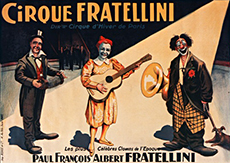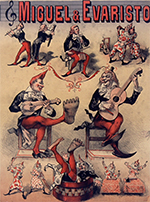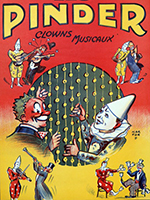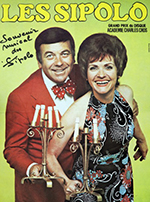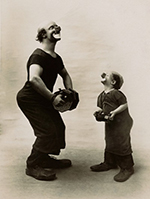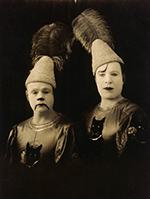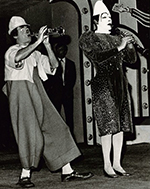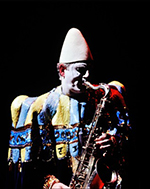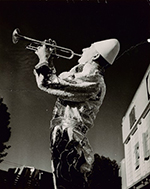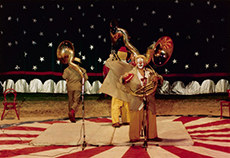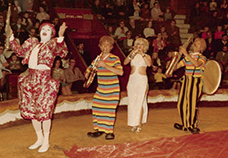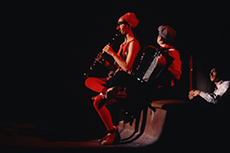by Marika Maymard
The clown is greedy. He avidly absorbs everything that amuses him and incorporates it into his practice to obtain comic effects. Acrobat, actor or musician, he works hard to reverse codes and pervert representation. The clarinet, the orphéon or the guitar often bear the brunt of virtuoso "transmutations". Dismantled, the melodic line breaks and ends in incongruities. The accumulation of objects diverted from their use associated with real instruments creates cacophony: the musician disappears behind the buffoon.
Influences
The musical clown is shaped by influences. The first days' clown squire, faithful to the military origins of the circus, walked to the sound of the drum and the call of the horns. The Latin clown, with the talkative sensuality of the payaso or the romantic lightness of the Italian Mezzetin, draws a romantic touch from his mandolin or guitar. When he is of English origin, he makes himself a white figure of a lunar Pierrot or a black, slender silhouette, with pointed poulaines on his feet and a fire-coloured wig with horns, between an evil Pierrot and a gesticulating Devil. He borrows their instruments from passing violinists or village orchestras. Coming from across the Atlantic, the black-faced minstrel parodies with a cheerful and rude anger the black slaves who sing and dance in the plantations. Creators of the caricatured character of the "Negro" with gigantic bare feet, they imported the banjo and variations of the washboard to accompany their grotesque wandering journeys. The Chantrells', the Belloninis, the Hulines, are contrasting the black faces with the white faces wearing tiny little hats and checked outfits to multiply their entries on stage or in the ring. Billy Hayden, the English clown eclipsed by George Foottit, who was inspired by him at the New Circus, first exploited the resources of the minstrels, as a fake black man, in the petticoats of a drag queen or as a clown with a flour-face. Foottit will take back his banjo.
Sounds and tones
When the clown starts his saga, he doesn't talk. To tell stories, he plays with his body or with some unusual props, a paper balloon, a tiny concertina or a small violin from the bottom of a pocket. Playing the role of the gadfly, the Auguste taunts the stage manager or the clown by punctuating his extravagances with unexpected sounds, from squeaking or clicking to the crash of cataclysmic incidents in the backstage area. Strange musical instruments join the dance such as a whistling glove, a flute, a rattle, a flexatone, a musical saw or bells in necklaces or hand and foot bracelets. The Webb brothers, Jojo and Rute, play a range of instruments, from the most classical to the most unusual, to express their duality, the grumpy melancholy of one of them in duo with the exuberant joy of his twin. In the following century, the Sipolos took a wide range of crystal-clear glasses, bells and bouteillophones to the Urals, performing a series of veritable symphonies. An astonishingly powerful and imaginative dialogue takes place through acrobatic and musical approaches. Those of the Plattier brothers, George and Samuel Locker and even Grock and Antonet, who endlessly adapt the Violons sauteurs or the Échelles animées created by John and William Price.
Dissonances
Buffoonery is the product of a combination of effects that are more or less expected and which become hilarious given their ability to surprise and build up. The Augustes fall into the bass drum or find themselves wearing a snorkel or an ophicleide. Freed from any authority, Grock began his show by completely ignoring the elegant solo musician he was supposed to be performing with. Engulfed in his vast houppelande, a felt-cap pressed against his bald skull, the charming grimacing man makes faces by wedging his tiny violin under his chin.
In the 20th century, the clown began talking and replies were exchanged, multiplying orders and disorders, from one end of the ring to the other. The flexible costume of the light mobile pixie, embodied by François Fratellini, gives way to the glitter bag that makes the clown's step heavier. Majestic, a little stiff in his luminous outfit, he took over the direction of operations with authority. Manu Barraceta, Rolf Zavatta, Yan Rossyan, Francesco Caroli, Alexis Grüss junior or Loretta rule over the Augustes, but remain authentic musicians.
The distortion between the very childish character of the clown, the mischievousness of the very clumsy contre-pitre clown who never understands anything and who whispers the worst nonsense at him and the clown's determination to play a song with his partners, suddenly fades into the final laughter. The Augustes of the Dario-Bario, Rudi-Llata, Di Lello or Rastelli who were fleeing the scramble, step into the ring, boldly blowing into bright, pristine horns or pushing from the collar to see above the bass drum that they almost smash with an enthusiastic mallet. The small group lines up to perform the finale, as close as possible to an audience holding its breath. Then comes Granada, reworked, amplified by the whole orchestra, or Aida's triumphal march that explodes. These Verdian bursts restore the epic image of the Fratellini trio raising towards the cupola some extraordinary trumpets with several mouthpieces or an enormous trunk wrapped around the Auguste! The orchestra is playing louder to make itself heard and the audience no longer knows whether to laugh or sing to their hearts' content.
Contemporary clowns rarely create new families, even if they are blended or reconstituted families, and the advent of the Nouveaux Nez, within the Centre national des arts du cirque de Châlons-en-Champagne, has suddenly taken on the appearance of a new beginning. Entering in duets or solos, Roseline Guinet, Alain Reynaud, Roger Bories and Nicolas Bernard will leave the Centre as a quartet for which music is essential. Cinq folies en cirque mineur is an unambiguous title and the sound universe of Les Nouveaux Nez will prove to be a revelation for tens of thousands of spectators all over the world. With them, as with the Orchestre formed by Amélie and Antony Venisse and Mirko Trierenberg, the music, which is improvised, carefully framed, between language and support, gives unexpected new colours to the contemporary clownish register.




